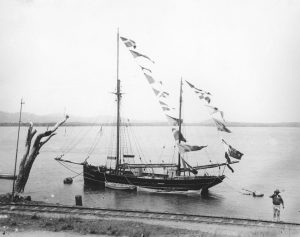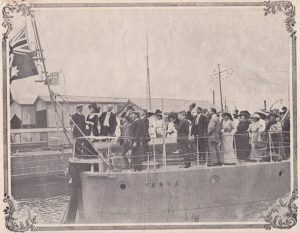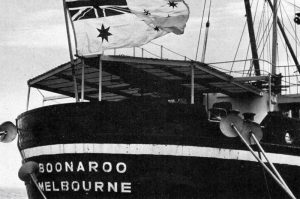- Author
- Rivett, Norman C
- Subjects
- History - general
- Tags
-
- RAN Ships
- HMAS Boonaroo
- Publication
- March 2017 edition of the Naval Historical Review (all rights reserved)
With the Australian White Ensign approaching its fiftieth anniversary on 1 March 2017 it is appropriate to reflect on the history of the revered ensign in its various forms with some relevant background.
When King James VI of Scotland became King James I of England in 1603 he desired that both countries be represented on a national flag which his subjects could fly on their ships. The result was the first Union flag which was introduced on the 12 April 1606. It was intended to be flown at the main top in all British ships and, as a concession to the Scots, either the Scottish or the English flags, those of St Andrew or St George, was to be flown in the foretop.
In 1634 the use of the Union flag was restricted to ships in the Royal Service by King Charles I and has never again been permitted to be used by merchant ships in its plain form.
The early method of dividing the English fleet into squadrons is said to have originated in the reign of Queen Elizabeth I (1558-1603). The earliest surviving instructions relating to the wearing of coloured flags to denote the three squadrons into which the fleet was divided, namely Red, Blue and White in that order of seniority, is dated 1617.
During the Commonwealth era (1649-1660) the ‘Council of State’ (1649-1653) changed the order of seniority of the squadron colours in 1653 to Red, White and Blue for unknown reasons.
In 1660 following the restoration of King Charles II and the re-establishment of the Union flag, its use was restricted to use by the King’s ships by the Lord High Admiral, the Duke of York, later King James II of England and VII of Scotland. However in 1674 English merchant vessels were allowed to fly a Red Ensign with the St. George’s Cross in the canton.
In 1702, in order to avoid confusion with the plain white field of the French ensign of Louis XIV (1643-1715), the Red Cross of St George was placed upon the fly of the White Ensign of the White Squadron which had hitherto been plain white. The plain White Ensign was retained for use in home waters until 1720.
With the Act of Union between England and Scotland under Queen Anne in 1707 the 1606 Union flag became the National flag of Britain and is sometimes referred to as Queen Anne’s flag. Squadron Ensigns wore the Union Flag in the canton. Merchant ships were then permitted to fly the Red Ensign with the Union flag in the canton instead of the Cross of St George.
As a result of the union of Ireland with England and Scotland in 1801, the 1606 style Union flag was redesigned to its present form and from 1 January 1801 became the national flag. Prior to the battle of Trafalgar on 21 October 1805, Lord Nelson, as Vice Admiral of the White Squadron, ordered all ships under his command, irrespective of their squadron colour, to fly the White Ensign and to fly the Union flag from a foremast stay in order to avoid confusion in battle.

On 5 August 1864 the Squadron colour system was abolished as being of no further relevance in the era of steam warships. The Red Ensign was allocated for use by the merchant navy, as it had been for a long time; the Royal Navy adopted the White Ensign, whilst the Blue Ensign was assigned to ships in government service.
Evolution of the Australian White Ensign
Before federation the Australian colonial navies flew the British Blue Ensign, defaced with the symbol of their relevant colony. When operating outside colonial waters, these ships were often temporarily commissioned into the Royal Navy, and consequently flew the British White Ensign. After Federation in 1901, ships of the newly formed Commonwealth Naval Force used the Australian National Flag in its original format with a six pointed Commonwealth Star which in 1908 became a seven pointed star.

With the formation of the Royal Australian Navy in 1911, RAN warships used the British White Ensign, with the Australian National Flag flown at the jack to signify their nationality. This situation served well and was used throughout two World Wars and the Korean War. However Australia’s participation in the Vietnam War created an unusual situation as this was the first time the Commonwealth had not fought alongside Britain. The British Government was embarrassed that its flag was being used in a conflict in which it was not involved.
During a Naval Estimates hearing in 1965, Samuel Benson, a Victorian politician, voiced concern on the use of the British White Ensign by Australian ships on wartime deployments, and Donald Chipp, Minister for the Navy, announced that an Australian ensign was under consideration. The Australian Naval Board later recommended the current design, which is identical to the Australian National Flag, but with the reversal of the blue background and the white Commonwealth Star and Southern Cross. This design was originally submitted by Commander (later Rear Admiral) G.J.H. Woolrych.
Following Royal Assent creation of the Australian White Ensign was announced by Prime Minister Harold Holt on 23 December 1966. It was intended that the change-over date for the new ensign would be Monday 1 May 1967, but this was brought forward to Wednesday 1 March 1967 to correspond with the commissioning of HMAS Boonaroo.

MV Boonaroo was an Australian National Line cargo ship supporting Australian forces in Vietnam. After completion of her initial voyage, members of the Seamen’s Union of Australia refused to sail on subsequent voyages to Vietnam in protest against Australia’s involvement in the conflict. Accordingly the ship was commissioned into the RAN as HMAS Boonaroo at 21.00 on 1 March 1967, becoming the first ship to be commissioned under the new ensign, and possibly the first to conduct this ceremony in darkness. All other RAN ships and establishments had previously raised the new ensign at morning colours on the same day. Boonaroo’s crew was replaced by RAN personnel, with the exception of two engineers who were commissioned into the RANR.
Summary
As this story tells us while we may only be celebrating ‘Fifty Years under the Australian White Ensign’ there is a relevant history extending back many centuries.




